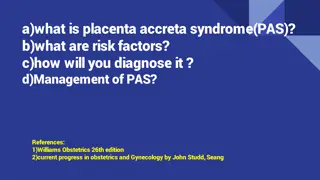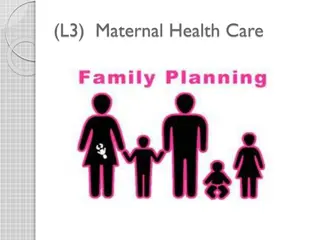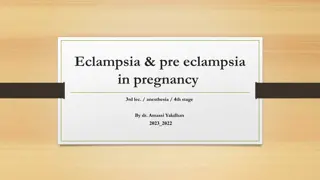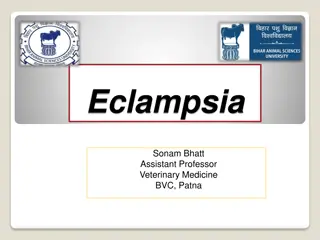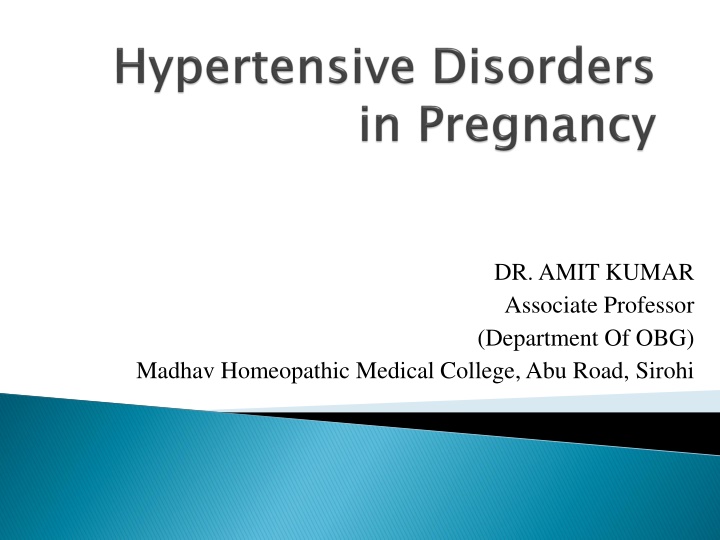
Pre-eclampsia: Definition, Diagnosis, and Risk Factors
Pre-eclampsia is a complex disorder affecting pregnant women, characterized by hypertension, proteinuria, and edema. Learn about its diagnostic criteria, incidence, risk factors like primigravida, family history, and placental abnormalities, and etiopathological factors. Early detection and management are crucial for ensuring maternal and fetal well-being.
Download Presentation

Please find below an Image/Link to download the presentation.
The content on the website is provided AS IS for your information and personal use only. It may not be sold, licensed, or shared on other websites without obtaining consent from the author. If you encounter any issues during the download, it is possible that the publisher has removed the file from their server.
You are allowed to download the files provided on this website for personal or commercial use, subject to the condition that they are used lawfully. All files are the property of their respective owners.
The content on the website is provided AS IS for your information and personal use only. It may not be sold, licensed, or shared on other websites without obtaining consent from the author.
E N D
Presentation Transcript
DR. AMIT KUMAR Associate Professor (Department Of OBG) Madhav Homeopathic Medical College, Abu Road, Sirohi
DEFINITION: Pre-eclampsia is a multisystem disorder of unknown etiology characterized by development of hypertension to the extent of 140/90 mm Hg or more with proteinuria after the 20th week in a previously normotensive and nonproteinuric woman. The preeclamptic features may appear even before the 20th week as in cases of hydatidiform mole and acute polyhydramnios.
The term, Pregnancy-induced hypertension (PIH) is defined as the hypertension that develops as a direct result of the gravid state. It includes Gestational hypertension, (i) (ii) Pre-eclampsia, and (iii) Eclampsia.
DIAGNOSTIC CRITERIA OF PRE-ECLAMPSIA Hypertension: An absolute rise of blood pressure of at least 140/90 mm Hg. Edema: Demonstration of pitting edema over the ankles after 12 hours bed rest or rapid gain in weight. Proteinuria: Presence of total protein in 24 hours urine of more than 0.3 gm or >2+ (1.0 gm/L)
INCIDENCE: The incidence of pre-eclampsia in hospital practice varies widely from 5 to 15%. The incidence in 10% and in The incidence in primigravidae 10% and in multigravidae primigravidae is about multigravidae 5%. is about 5%.
RISK FACTORS FOR PRE-ECLAMPSIA Primigravida: Young or elderly (first time exposure to chorionic villi) Family history: Hypertension, pre-eclampsia Placental abnormalities: Hyperplacentosis: Excessive exposure to chorionic villi (molar pregnancy twins, diabetes) Placental ischemia. Obesity Pre-existing vascular disease. New paternity. Thrombophilias
ETIOPATHOLOGICAL FACTORS FOR PRE- ECLAMPSIA Failure of trophoblast placentation) Vascular endothelial damage Inflammatory mediators (cytokines) Immunological intolerance between maternal and fetal tissues Coagulation abnormalities Increased oxygen free radicals Genetic predisposition (polygenic disorder) Dietary dieficiency or excess invasion (abnormal
CLINICALTYPES Mild: This includes cases of sustained rise of blood pressure of more than 140/90 mm Hg but less than 160 mm Hg systolic or 110 mm Hg diastolic without significant proteinuria. Severe: (1) A persistent systolic blood pressure of >160 mm Hg or diastolic pressure of >110 mm Hg. (2) Protein excretion of >5 gm/24 hr.
(3) Oliguria (<400 ml/24 hr). (4) Platelet count < 100,000/mm3. (5) HELLP syndrome. (6) Cerebral or visual disturbances. (7) Persistent severe epigastric pain. (8) Retinal hemorrhages, exudates or papilledema. (9) Intrauterine growth restriction of the fetus. (10) Pulmonary edema.
CLINICAL FEATURES Mild symptoms: Slight swelling over the ankles which persists on rising from the bed in the morning or tightness of the ring on the finger is the early manifestation of pre-eclampsia edema. Gradually, the swelling may extend to the face, abdominal wall, vulva and even the whole body
Alarming symptoms (1) Headache either located over the occipital or frontal region (2) Disturbed sleep (3) Diminished urinary output Urinary output of less than 400 ml in 24 hours is very ominous, (4) Epigastric pain acute pain in the epigastric region associated with vomiting, at times coffee color, is due to hemorrhagic gastritis or due to subcapsular hemorrhage in the liver, (5) Eye symptoms there may be blurring, scotomata, dimness of vision or at times complete blindness.
SIGNS Abnormal weight gain Rise of blood pressure Edema There is no manifestation of chronic cardiovascular or renal pathology. Pulmonary edema due to leaky capillaries and low oncotic pressure. Abdominal examination may reveal evidences of chronic placental insufficiency, such as scanty liquorm or growth retardation of the fetus. 1. 2. 3. 4. 5. 6.
Rapid gain in weight Visible edema and/or hypertension Proteinuria
INVESTIGATIONS Urine Ophthalmoscopic examination Blood values Antenatal fetal monitoring COMPLICATIONS OF PRE-ECLAMPSIA Immediate: (1) Maternal (2) Fetal Remote
IMMEDIATE: Maternal During pregnancy: (a) Eclampsia (2%) more in acute than in subacute cases, (b) Accidental hemorrhage, (c) Oliguria and anuria, (d) Dimness of vision and even blindness, (e) Preterm labor, (f) HELLP syndrome, (g) Cerebral hemorrhage, (h) Acute respiratory distress syndrome (ARDS)
During labor: (a) Eclampsia, (b) Postpartum hemorrhage may be related with coagulation failure Puerperium: (a) Eclampsia usually occurs within 48 hours. (b) Shock puerperal vasomotor collapse . (c) Sepsis due to increased incidence of induction, operative interference, and low vitality.
Fetal (a) Intrauterine death due to spasm of uteroplacental circulation leading to accidental hemorrhage or acute red infarction, (b) Intrauterine growth restriction due to chronic placental insufficiency, (c) Asphyxia, (d) Prematurity either due to spontaneous preterm onset of labor or due to preterm induction.
REMOTE Residual hypertension: Recurrent pre-eclampsia: Chronic renal disease: Risk of placental abruption for those women with pre- eclampsia ranges from 5 20 percent and
OBJECTIVES ARE: (1) To stabilise hypertension and to prevent its progression to severe pre-eclampsia. (2) To prevent the complications (3) To prevent eclampsia. (4) Delivery of a healthy baby in optimal time. (5) Restoration of the health of the mother in puerperium.
PROPHYLACTIC PREVENTION OF PRE-ECLAMPSIA MEASURES FO Regular antenatal check up for early detection of rapid gain in weight or a tendency of rising blood pressure specially the diastolic one. Antithrombotic agents: Low dose aspirin 60 mg daily beginning early in pregnancy in potentially high risk patients is given.
Heparin or low molecular weight heparin is useful in women with thrombophilia and with high risk pregnancy. Calcium supplementation (2 gm per day) reduces the risk of gestational hypertension. Antioxidants, vitamins E and C and nutritional supplementation with magnesium, zinc, fish oil and low salt diet have been tried but are of limited benefit. Balanced diet rich in protein may reduce the risk.



